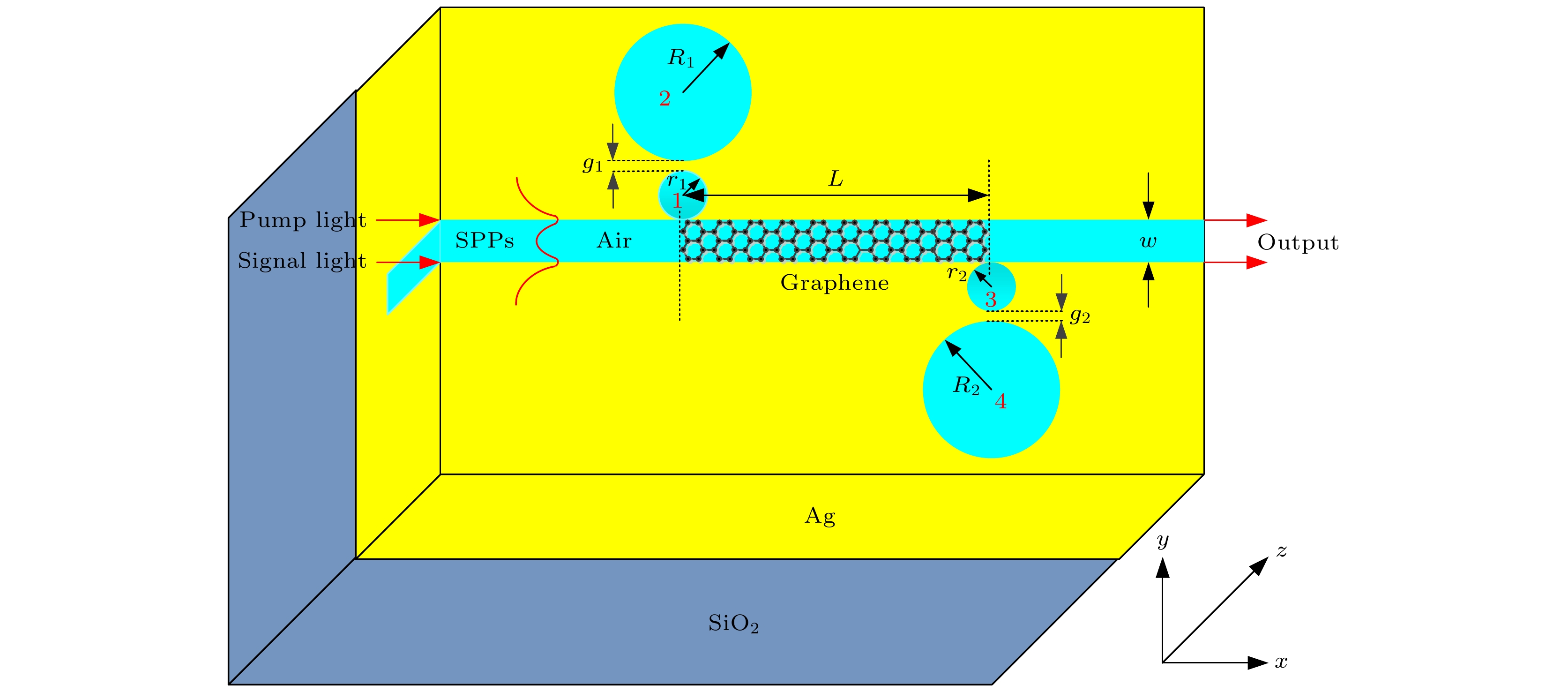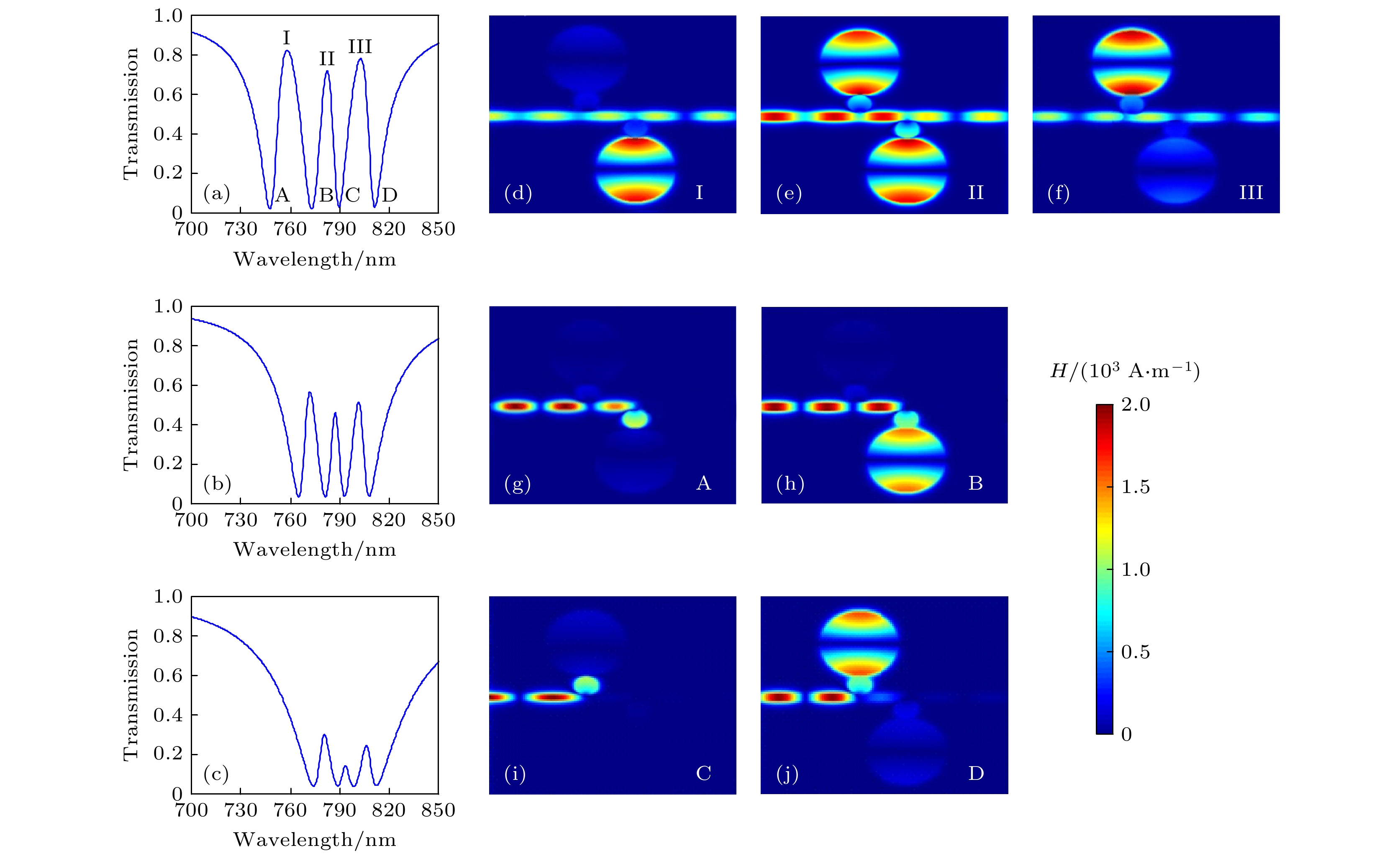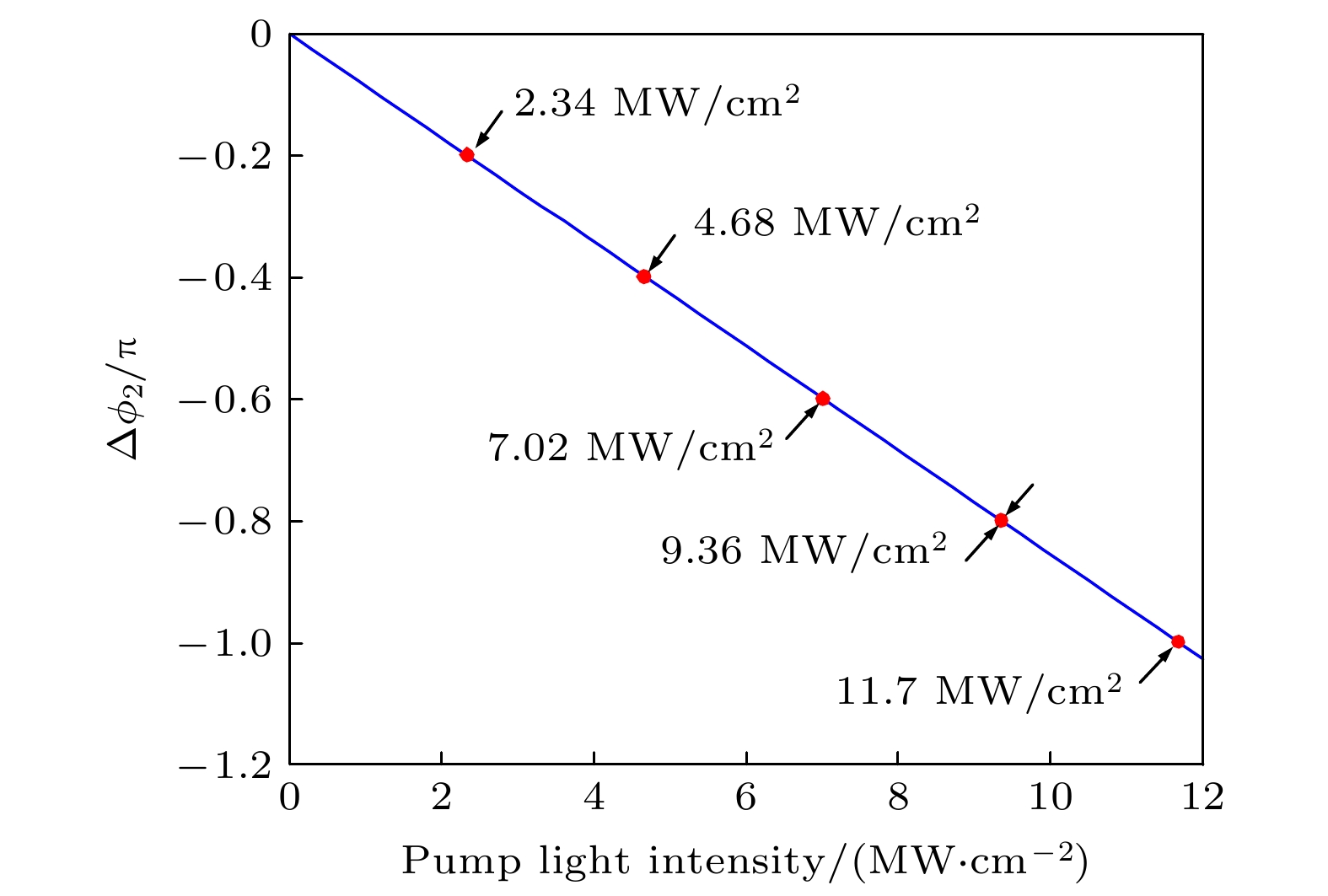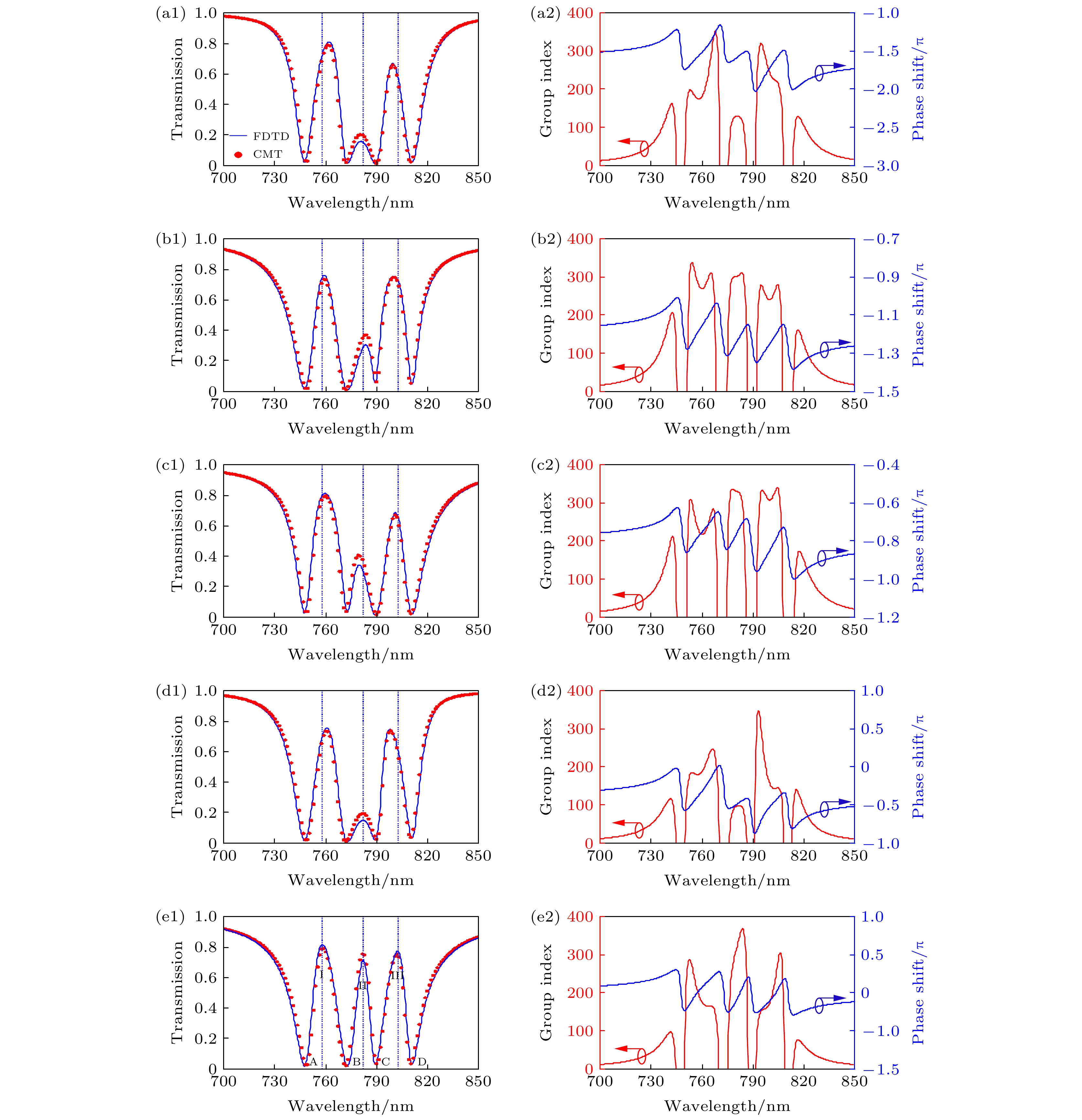-
为了降低功耗、实现超快速响应和动态可调谐, 设计了基于四盘形谐振腔耦合等离子体波导系统. 使用两种不同的方法理论分析了等离子体诱导透明(PIT)效应: 一种是明暗模式谐振腔之间的直接相消干涉, 另一种是谐振腔之间通过等离子体波导的间接耦合. 采用光学Kerr效应超快调控石墨烯-Ag复合材料波导的传输相移, 实现了1 ps量级的超快响应时间. 当泵浦光强低至11.7 MW/cm2时, 等离子体诱导透明系统能够实现透射光谱2π相移. 通过耦合模式理论和时域有限差分法, 研究了模型的三波段PIT效应及其慢光特性. 研究表明, 系统透射谱的透射峰值超过80%, 最大群折射率高达368. 并且, 整个系统的尺寸小于0.5 μm2. 研究结果为低功耗、超快速、超紧凑型和动态可调谐的多通道光滤波和光存储器件的设计和制作提供了思路.In order to reduce power consumption and realize ultrafast response time and dynamic tunability, a plasmonic waveguide system based on four disk resonators is designed. A plasmon induced transparency effect is theoretically analyzed by using two different methods: one is the direct destructive interference between bright mode resonator and dark mode resonator, and the other is the indirect coupling through a plasmonic waveguide. Owing to the giant effective nonlinear Kerr coefficient of the graphene-Ag composite material structure and the enhancement characteristics of slow light response to optical Kerr effect, the pump intensity of PIT system for changing the phase shift of transmission spectrum is greatly reduced. An ultrafast response time of 1 ps is achieved, and 0.4π, 0.8π, 1.2π, 1.6π and 2π-phase shift of the transmission spectrum in the plasmon induced transparency system are achieved with the intensity of the pump light as low as 2.34, 4.68, 7.02, 9.36, 11.7 MW/cm–2, respectively. In this work, a plasmonic waveguide coupled directly by two small disk resonators is employed, because two small disk resonators play a role of the slit between the waveguide and the resonators, and also act as two separate resonators side-coupled with a plasmonic waveguide, which leads to the more efficient coupling of electromagnetic energy in the waveguide into the big disk resonators to form resonance and easier storage of light in the resonator. The triple-band plasmon induced transparency (PIT) effect and slow light properties of the model are analyzed by the expression of the deduced theoretical transmittance based on the coupled mode theory, indicating that they are very consistent with the finite-difference time-domain simulations. The results show that the transmission peak of the system is over 80% and the maximum group index is as high as 368. Furthermore, the disk resonators are easy to fabricate and the size of the entire PIT structure is < 0.5 μm2, which is beneficial to the design of optoelectronic device on-chip integration. The research results have important application prospects in highly integrating optical circuits and networks, and also provide the ideas for the design and fabrication of multi-channel optical filter and light storage devices with low power consumption, ultrafast nonlinear response, ultracompact and dynamical tunability.
-
Keywords:
- slow light /
- plasmon induced transparency /
- finite difference time domain /
- graphene
[1] Harris S E, Field J E, Imamoglu A 1990 Phys. Rev. Lett. 64 1107
 Google Scholar
Google Scholar
[2] Kekatpure R D, Barnard E S, Cai W, Brongersma M L 2010 Phys. Rev. Lett. 104 243902
 Google Scholar
Google Scholar
[3] Luk'yanchuk B, Zheludev N I, Maier S A, Halas N J, Nordlander P, Giessen H, Chong C T 2010 Nat. Mater. 9 707
 Google Scholar
Google Scholar
[4] Zhao F, Lin J, Lei Z, Yi Z, Qin F, Zhang J, Liu L, Wu X, Yang W, Wu P 2022 Phys. Chem. Chem. Phys. 24 4871
 Google Scholar
Google Scholar
[5] Lai G, Liang R S, Zhang Y J, Bian Z Y, Yi L X, Zhan G Z, Zhao R T 2015 Opt. Express 23 6554
 Google Scholar
Google Scholar
[6] Wang B Y, Zeng Q D, Xiao S Y, Xu C, Xiong L B, Lv H, Du J, Yu H Q 2017 J. Phys. D: Appl. Phys. 50 455107
 Google Scholar
Google Scholar
[7] 王波云, 朱子豪, 高有康, 曾庆栋, 刘洋, 杜君, 王涛, 余华清 2022 71 024201
 Google Scholar
Google Scholar
Wang B Y, Zhu Z H, Gao Y K, Zeng Q D, Liu Y, Du J, Wang T, Yu H Q 2022 Acta Phys. Sin. 71 024201
 Google Scholar
Google Scholar
[8] Zeng Y, Ling Z X, Liu G D, Wang L L, Lin Q 2022 Opt. Express 30 14103
 Google Scholar
Google Scholar
[9] Zheng Z, Luo Y, Yang H, Yi Z, Zhang J, Song Q, Yang W, Liu C, Wu X, Wu P 2022 Phys. Chem. Chem. Phys. 24 8846
 Google Scholar
Google Scholar
[10] Huang H L, Xia H, Guo Z B, Li H J, Xie D 2018 Opt. Commun. 424 163
 Google Scholar
Google Scholar
[11] Zhang S, Genov D A, Wang Y, Liu M, Zhang X 2008 Phys. Rev. Lett. 101 047401
 Google Scholar
Google Scholar
[12] Zhang T, Liu Q, Dan Y H, Yu S, Han X, Dai J, Xu K 2020 Opt. Express 28 18899
 Google Scholar
Google Scholar
[13] Liu Z M, Zhang X, Zhang Z B, Gao E D, Zhou F Q, Hong J L, Luo X 2020 New J. Phys. 22 083006
 Google Scholar
Google Scholar
[14] Zheng Z, Zheng Y, Luo Y, Yi Z, Zhang J, Liu Z, Yang W, Yu Y, Wu X, Wu P 2022 Phys. Chem. Chem. Phys. 24 2527
 Google Scholar
Google Scholar
[15] Zhang X, Zhou F Q, Liu Z M, Zhang Z B, Qin Y P, Zhuo S S, Luo X, Gao E D, Li H J 2021 Opt. Express 29 29387
 Google Scholar
Google Scholar
[16] Zentgraf T, Zhang S, Oulton R F, Zhang X 2009 Phys. Rev. B 80 195415
 Google Scholar
Google Scholar
[17] Wu X, Zheng Y, Luo Y, Zhang J, Yi Z, Wu X, Cheng S, Yang W, Yu Y, Wu P 2021 Phys. Chem. Chem. Phys. 23 26864
 Google Scholar
Google Scholar
[18] Lu H, Liu X, Mao D 2012 Phys. Rev. A 85 053803
 Google Scholar
Google Scholar
[19] Han X, Wang T, Li X, Xiao S, Zhu Y 2015 Opt. Express 23 31945
 Google Scholar
Google Scholar
[20] Saraswat V, Jacobberger R M, Arnold M S 2021 ACS Nano 15 3674
 Google Scholar
Google Scholar
[21] Zhou F, Qin F, Yi Z, Yao W, Liu Z, Wu X, Wu P 2021 Phys. Chem. Chem. Phys. 23 17041
 Google Scholar
Google Scholar
[22] Zhang T, Zhou J Z, Dai J, Dai Y T, Han X, Li J Q, Yin F F, Zhou Y, Xu K 2018 J. Phys. D: Appl. Phys. 51 055103
 Google Scholar
Google Scholar
[23] Nikolaenko A E, Papasimakis N, Atmatzakis E, Luo Z, Shen Z X, Angelis F D, Boden S A, Fabrizio E D, Zheludev N I 2012 Appl. Phys. Lett. 100 181109
 Google Scholar
Google Scholar
[24] Li X, Cai W, An J, Kim S, Nah J, Yang D, Piner R, Velamakanni A, Jung I, Tutuc E 2009 Science 324 1312
 Google Scholar
Google Scholar
[25] Suk J W, Kitt A, Magnuson C W, Hao Y, Ahmed S, An J, Swan A K, Goldberg B B, Ruoff R S 2011 ACS Nano 5 6916
 Google Scholar
Google Scholar
[26] Wu J B, Jin B B, Wan J, Liang L J, Zhang Y G, Jia T, Cao C H, Kang L, Xu W W, Chen J, Wu P H 2011 Appl. Phys. Lett. 99 161113
 Google Scholar
Google Scholar
[27] Lu H, Liu X, Wang L, Gong Y, Mao D 2011 Opt. Express 19 2910
 Google Scholar
Google Scholar
[28] 褚培新, 张玉斌, 陈俊学 2020 69 134205
 Google Scholar
Google Scholar
Chu P X, Zhang Y B, Chen J X 2020 Acta Phys. Sin. 69 134205
 Google Scholar
Google Scholar
[29] Lei F, Gao M, Du C, Jing Q L, Long G L 2015 Opt. Express 23 11508
 Google Scholar
Google Scholar
[30] Zhu Y, Hu X Y, Yang H, Gong Q H 2014 Sci. Rep. 104 211108
 Google Scholar
Google Scholar
[31] 陈颖, 谢进朝, 周鑫德, 张灿, 杨惠, 李少华 2019 68 237301
 Google Scholar
Google Scholar
Chen Y, Xie J C, Zhou X D, Zhang C, Yang H, Li S H 2019 Acta Phys. Sin. 68 237301
 Google Scholar
Google Scholar
[32] Ren T X, Chen L 2019 Opt. Lett. 44 5446
 Google Scholar
Google Scholar
[33] Ma Q L, Hong W Y, Shui L L 2022 Opt. Express 30 3055
 Google Scholar
Google Scholar
[34] Wang B K, Guo T, Gai K, Yan F, Wang R X, Li L 2022 Appl. Opt. 61 3218
 Google Scholar
Google Scholar
[35] Xu H, Xiong C X, Chen Z Q, Zheng M F, Zhao M Z, Zhang B H, Li H J 2018 J. Opt. Soc. Am. B 35 1463
 Google Scholar
Google Scholar
[36] Han X, Wang T, Li X, Liu B, He Y, Tang J 2015 J. Phys. D:Appl. Phys. 48 235102
 Google Scholar
Google Scholar
[37] Wang B Y, Zhu Y H, Zhang J, Zeng Q D, Du J, Wang T, Yu H Q 2020 Chin. Phys. B 29 084211
 Google Scholar
Google Scholar
-
图 1 (a) 小盘形谐振腔直接耦合MIM波导的结构; (b) 小盘形谐振腔的半径r不同时, 结构的透射光谱 (图(b)插图为r = 65 nm、波长为749 nm时透射凹陷处的磁场分布)
Fig. 1. (a) Schematic diagram of a small disk resonator directly coupled to a MIM waveguide; (b) transmission spectra of thestructure with the different radius of the small disk resonator r (The inset in panel (b) shows the magnetic field distribution at the transmission dip wavelength of 749 nm with r = 65 nm).
图 4 (a)—(c) 不同ΔR下系统的透射谱, 其中(a) ΔR = 6 nm, (b) ΔR = 4 nm, (c) ΔR = 2 nm; (d)—(j)当ΔR = 6 nm时, 系统在不同波长处的磁场分布, 其中(d) λI = 758 nm, (e) λII= 782 nm, (f) λIII = 803 nm, (g) λA = 747 nm, (h) λB = 773 nm, (i) λC = 789 nm, (j) λD = 811 nm
Fig. 4. (a)–(c) Transmission spectra with various radius detuning ΔR: (a) ΔR = 6 nm; (b) ΔR = 4 nm; (c) ΔR = 2 nm. (d)–(j) Magnetic field distributions corresponding to different wavelengths with ΔR = 6 nm: (d) λI = 758 nm; (e) λII = 782 nm; (f) λIII = 803 nm; (g) λA = 747 nm; (h) λB = 773 nm; (i) λC = 789 nm; (j) λD = 811 nm.
图 7 不同泵浦光强调谐下, (a1)—(e1)三波段PIT效应归一化透射谱及(a2)—(e2)相应的相移响应和群折射率 (a1), (a2) I = 2.34 MW/cm2, Δϕ = 0.8π; (b1), (b2) I = 4.68 MW/cm2, Δϕ = 0.6π; (c1), (c2) I = 7.02 MW/cm2, Δϕ = 0.4π; (d1), (d2) I = 9.36 MW/cm2, Δϕ = 0.2π; (e1), (e2) I = 11.70 MW/cm2, Δϕ = 0
Fig. 7. (a1)–(e1) Transmission spectra of tiple PIT effect with (a2)—(e2) corresponding phase shift responses and group indexunder different pump light intensity: (a1), (a2) I = 2.34 MW/cm2, Δϕ = 0.8π; (b1), (b2) I = 4.68 MW/cm2, Δϕ = 0.6π; (c1), (c2) I = 7.02 MW/cm2, Δϕ = 0.4π; (d1), (d2) I = 9.36 MW/cm2, Δϕ = 0.2π; (e1), (e2) I = 11.70 MW/cm2, Δϕ = 0.
表 1 不同结构模型的PIT波段数量、最大透射率和最大群折射率的对比
Table 1. Comparison of the number of PIT band, maximum transmission and maximum group index of different structural models.
-
[1] Harris S E, Field J E, Imamoglu A 1990 Phys. Rev. Lett. 64 1107
 Google Scholar
Google Scholar
[2] Kekatpure R D, Barnard E S, Cai W, Brongersma M L 2010 Phys. Rev. Lett. 104 243902
 Google Scholar
Google Scholar
[3] Luk'yanchuk B, Zheludev N I, Maier S A, Halas N J, Nordlander P, Giessen H, Chong C T 2010 Nat. Mater. 9 707
 Google Scholar
Google Scholar
[4] Zhao F, Lin J, Lei Z, Yi Z, Qin F, Zhang J, Liu L, Wu X, Yang W, Wu P 2022 Phys. Chem. Chem. Phys. 24 4871
 Google Scholar
Google Scholar
[5] Lai G, Liang R S, Zhang Y J, Bian Z Y, Yi L X, Zhan G Z, Zhao R T 2015 Opt. Express 23 6554
 Google Scholar
Google Scholar
[6] Wang B Y, Zeng Q D, Xiao S Y, Xu C, Xiong L B, Lv H, Du J, Yu H Q 2017 J. Phys. D: Appl. Phys. 50 455107
 Google Scholar
Google Scholar
[7] 王波云, 朱子豪, 高有康, 曾庆栋, 刘洋, 杜君, 王涛, 余华清 2022 71 024201
 Google Scholar
Google Scholar
Wang B Y, Zhu Z H, Gao Y K, Zeng Q D, Liu Y, Du J, Wang T, Yu H Q 2022 Acta Phys. Sin. 71 024201
 Google Scholar
Google Scholar
[8] Zeng Y, Ling Z X, Liu G D, Wang L L, Lin Q 2022 Opt. Express 30 14103
 Google Scholar
Google Scholar
[9] Zheng Z, Luo Y, Yang H, Yi Z, Zhang J, Song Q, Yang W, Liu C, Wu X, Wu P 2022 Phys. Chem. Chem. Phys. 24 8846
 Google Scholar
Google Scholar
[10] Huang H L, Xia H, Guo Z B, Li H J, Xie D 2018 Opt. Commun. 424 163
 Google Scholar
Google Scholar
[11] Zhang S, Genov D A, Wang Y, Liu M, Zhang X 2008 Phys. Rev. Lett. 101 047401
 Google Scholar
Google Scholar
[12] Zhang T, Liu Q, Dan Y H, Yu S, Han X, Dai J, Xu K 2020 Opt. Express 28 18899
 Google Scholar
Google Scholar
[13] Liu Z M, Zhang X, Zhang Z B, Gao E D, Zhou F Q, Hong J L, Luo X 2020 New J. Phys. 22 083006
 Google Scholar
Google Scholar
[14] Zheng Z, Zheng Y, Luo Y, Yi Z, Zhang J, Liu Z, Yang W, Yu Y, Wu X, Wu P 2022 Phys. Chem. Chem. Phys. 24 2527
 Google Scholar
Google Scholar
[15] Zhang X, Zhou F Q, Liu Z M, Zhang Z B, Qin Y P, Zhuo S S, Luo X, Gao E D, Li H J 2021 Opt. Express 29 29387
 Google Scholar
Google Scholar
[16] Zentgraf T, Zhang S, Oulton R F, Zhang X 2009 Phys. Rev. B 80 195415
 Google Scholar
Google Scholar
[17] Wu X, Zheng Y, Luo Y, Zhang J, Yi Z, Wu X, Cheng S, Yang W, Yu Y, Wu P 2021 Phys. Chem. Chem. Phys. 23 26864
 Google Scholar
Google Scholar
[18] Lu H, Liu X, Mao D 2012 Phys. Rev. A 85 053803
 Google Scholar
Google Scholar
[19] Han X, Wang T, Li X, Xiao S, Zhu Y 2015 Opt. Express 23 31945
 Google Scholar
Google Scholar
[20] Saraswat V, Jacobberger R M, Arnold M S 2021 ACS Nano 15 3674
 Google Scholar
Google Scholar
[21] Zhou F, Qin F, Yi Z, Yao W, Liu Z, Wu X, Wu P 2021 Phys. Chem. Chem. Phys. 23 17041
 Google Scholar
Google Scholar
[22] Zhang T, Zhou J Z, Dai J, Dai Y T, Han X, Li J Q, Yin F F, Zhou Y, Xu K 2018 J. Phys. D: Appl. Phys. 51 055103
 Google Scholar
Google Scholar
[23] Nikolaenko A E, Papasimakis N, Atmatzakis E, Luo Z, Shen Z X, Angelis F D, Boden S A, Fabrizio E D, Zheludev N I 2012 Appl. Phys. Lett. 100 181109
 Google Scholar
Google Scholar
[24] Li X, Cai W, An J, Kim S, Nah J, Yang D, Piner R, Velamakanni A, Jung I, Tutuc E 2009 Science 324 1312
 Google Scholar
Google Scholar
[25] Suk J W, Kitt A, Magnuson C W, Hao Y, Ahmed S, An J, Swan A K, Goldberg B B, Ruoff R S 2011 ACS Nano 5 6916
 Google Scholar
Google Scholar
[26] Wu J B, Jin B B, Wan J, Liang L J, Zhang Y G, Jia T, Cao C H, Kang L, Xu W W, Chen J, Wu P H 2011 Appl. Phys. Lett. 99 161113
 Google Scholar
Google Scholar
[27] Lu H, Liu X, Wang L, Gong Y, Mao D 2011 Opt. Express 19 2910
 Google Scholar
Google Scholar
[28] 褚培新, 张玉斌, 陈俊学 2020 69 134205
 Google Scholar
Google Scholar
Chu P X, Zhang Y B, Chen J X 2020 Acta Phys. Sin. 69 134205
 Google Scholar
Google Scholar
[29] Lei F, Gao M, Du C, Jing Q L, Long G L 2015 Opt. Express 23 11508
 Google Scholar
Google Scholar
[30] Zhu Y, Hu X Y, Yang H, Gong Q H 2014 Sci. Rep. 104 211108
 Google Scholar
Google Scholar
[31] 陈颖, 谢进朝, 周鑫德, 张灿, 杨惠, 李少华 2019 68 237301
 Google Scholar
Google Scholar
Chen Y, Xie J C, Zhou X D, Zhang C, Yang H, Li S H 2019 Acta Phys. Sin. 68 237301
 Google Scholar
Google Scholar
[32] Ren T X, Chen L 2019 Opt. Lett. 44 5446
 Google Scholar
Google Scholar
[33] Ma Q L, Hong W Y, Shui L L 2022 Opt. Express 30 3055
 Google Scholar
Google Scholar
[34] Wang B K, Guo T, Gai K, Yan F, Wang R X, Li L 2022 Appl. Opt. 61 3218
 Google Scholar
Google Scholar
[35] Xu H, Xiong C X, Chen Z Q, Zheng M F, Zhao M Z, Zhang B H, Li H J 2018 J. Opt. Soc. Am. B 35 1463
 Google Scholar
Google Scholar
[36] Han X, Wang T, Li X, Liu B, He Y, Tang J 2015 J. Phys. D:Appl. Phys. 48 235102
 Google Scholar
Google Scholar
[37] Wang B Y, Zhu Y H, Zhang J, Zeng Q D, Du J, Wang T, Yu H Q 2020 Chin. Phys. B 29 084211
 Google Scholar
Google Scholar
计量
- 文章访问数: 5261
- PDF下载量: 87
- 被引次数: 0














 下载:
下载:







